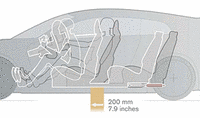2005 NAIAS- Volvo Safety
DETROIT, Mich., Jan. 12, 2005 -- Volvo plans to significantly increase the safety of drivers and passengers in small cars during a frontal crash. The company displayed its 3CC concept vehicle, which demonstrates Volvo's new Safety Ride Down Concept, at the North American International Auto Show.
This concept, which focuses on a moveable steering wheel, instrument panel, pedals, and front seat, could be migrated into Volvo production over the next several years.
"Crash safety is a real challenge in a smaller, light-weight car because it has a shorter crumple zone," said Lex Kerssemakers, senior vice president, Brand, Business and Product Strategy, Volvo Car Corporation.
In a small car like the 3CC, the car?s deformation is limited. In order to compensate for this, an increase in the interior ride-down length is necessary. With this approach it is possible to provide a similar level of soft stop for the occupant despite the limited car deformation available.
The Volvo Safety Ride Down Concept works like this: When a small car equipped with the Safety Ride Down Concept gets hit in the front, the whole seat system slides forward (up to 8 inches), similar to a sled. At the same time, the front end crumples. Electronically controlled shock absorbers adjust the seat system's forward motion based on the force of the collision and the weight of the front seat occupants. The steering wheel and dash panel move forward as well, creating space for the driver's movement forward.
When a small car, equipped with the Volvo Safety Ride Down Concept, gets hit in the front, both the front and rear seat systems move forward (up to eight inches) on a sliding floor pan, similar to a sled, at the same time the vehicle front end crumples. ?The Volvo Safety Ride Down Concept has been tested in a virtual environment for over three years," said Kolita Mendis, manager, Structures and Safety Engineering, Volvo Monitoring and Concept Centre. ?The tests give us a pretty good picture of the forces we?re up against and how best to handle them.
"The Volvo Safety Ride Down Concept has appeared from time to time as an interior safety concept proposal in one form or another for more than 40 years," Mendis added. "Our virtual testing has showed that the most important part of a ride-down system is the energy absorber, and that it needs to be adaptive in order to be a viable concept, by responding to differences in occupant load and crash severity."
The dampers that are used to retard the movement of the interior are based on the same technology as those found in adaptive shock absorbers that were first introduced in Volvo?s advanced R-models. Prototypes have been further developed in cooperation with two Swedish universities, the Chalmers University of Technology in G÷teborg and Luleň University.
The dampers are hydraulic and operate electronically. These dampers can be adjusted every two milliseconds. The impulses can come from a number of sensors that read off such parameters as vehicle and seat deceleration, as well as inputs from the occupant restraint system.
?The Volvo Safety Ride Down Concept is a promising stage in our protective safety development,? said Ingrid Skogsmo, director, Volvo Cars Safety. ?We?ve learned a lot in the process. The next step could be to continue developing technologies from the concept stage.?



